With the onset of warm spring days, many people think about going out into nature or to their country house in order to relax after the winter cold and eat delicious kebabs with a real aroma of smoke of pine, cherry, apricot or apple twigs. And for this you need a metal grill. Naturally, it can be purchased at the store, but if you are not too lazy to spend a few hours of your time, you can make an excellent metal grill with your own hands that will delight you and your loved ones with delicious kebabs for many years.
Pros and cons of a metal brazier. Its features
If you decide to make a brazier out of metal (steel) yourself, then first of all you need to decide what size will be optimal in order to meet the needs of your entire family, and also which metal will serve your purposes the longest.
Today, there are a large number of varieties of barbecues that can be made from a wide variety of materials, but metal is the most popular among them, as it has many undeniable advantages, such as:
- Mobility. Even if the brazier is not folding, it can still be easily transferred to any utility room (basement, closet, garage, pantry), where it will be securely hidden from the effects of various atmospheric precipitation until its next use.
- Fire safety. Even in the event of an accidental strong fire of firewood or coal, the dimensions and metal of the brazier can prevent the occurrence of a fire hazard. Metal can become very hot, but since it does not burn, a fire cannot occur.
- Affordable price. Metal is currently the most accessible and inexpensive material for making any type of barbecue compared to refractory bricks, natural stone, or other expensive materials.
- Manufacturing speed. With the availability of material and a welding machine, such a brazier can be made in just a few hours and immediately operated, while a brick structure will have to be made for at least a month and it will not be possible to operate it for a few more days.
- Ease of use. The metal brazier is easy to clean, wash and, if necessary, disassemble or fold (if it is collapsible or folding).
- The speed of cooking. Since the metal perfectly retains heat, meat, vegetables and other products will cook on it quickly enough and bake evenly.
The only drawback of this design can be called an unaesthetic appearance. But if you are a jack of all trades, then you can make not just a brazier out of metal, but a real work of art. The metal is also susceptible to corrosion, but if you treat it with special anti-corrosion agents and take care of the product made from it, then it will serve you for decades.
Photo: types of design of metal structures
Let's see what unusual and beautiful barbecues can be made from iron, steel and improvised means, if there is at least a little imagination and "golden hands" of the master.
Here's a beautiful brazier you can make with your own hands for your home 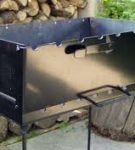 Stationary brazier in a strict classic style made of stainless steel, which will decorate any personal plot
Stationary brazier in a strict classic style made of stainless steel, which will decorate any personal plot 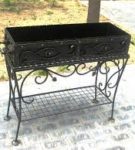 Stationary metal brazier with skillful decoration
Stationary metal brazier with skillful decoration 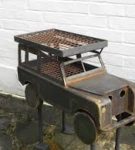 This brazier in the form of a car will look great in the yard of a motorist
This brazier in the form of a car will look great in the yard of a motorist 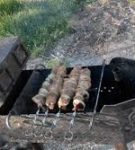 This brazier in the form of a ship will allow you to sail away into the sea of pleasure from the aroma of kebabs
This brazier in the form of a ship will allow you to sail away into the sea of pleasure from the aroma of kebabs  such a brazier - a pig is sure to please your children and they will be happy to help you fry kebabs
such a brazier - a pig is sure to please your children and they will be happy to help you fry kebabs 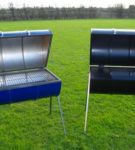 Such magnificent braziers from cans are simply indistinguishable from the factory
Such magnificent braziers from cans are simply indistinguishable from the factory
Preparation for construction: drawings, diagrams, what should be the optimal dimensions and device
The size of the brazier that you are going to make must meet your requirements and take into account all the conditions for its operation.
- If your family consists of three or four people, then a 50x30 cm product will suit you.
- The width of a conventional barbecue is 30 cm. This distance is calculated for one skewer, which will fit eight or nine small pieces of pork or veal per serving.
- The length of the brazier can be different based on the number of skewers that will need to be laid next to each other. The distance between the skewers should be about 10 cm, so for 8 pieces it is necessary to measure 80 cm of the sheet length, for 10-1 meter, etc. But you should not make a barbecue too long, as it will simply be inconvenient and it will turn out to be too bulky and absurd.
- The depth should be about 15 – 20 cm. This volume will be quite enough for a person to be able to place logs or coals in the barbecue, as well as meat, so that later, when frying, it does not come into contact with burning coals and does not burn.
- The height of the “box” from the bottom to the legs should be such that a person can stand straight, hold a skewer in a bent hand and turn it over while frying the barbecue.
- For the manufacture of legs, you can take the corners (25 – 30 mm shelves) or four pieces of conventional reinforcement (diameter 8 – 10 mm).
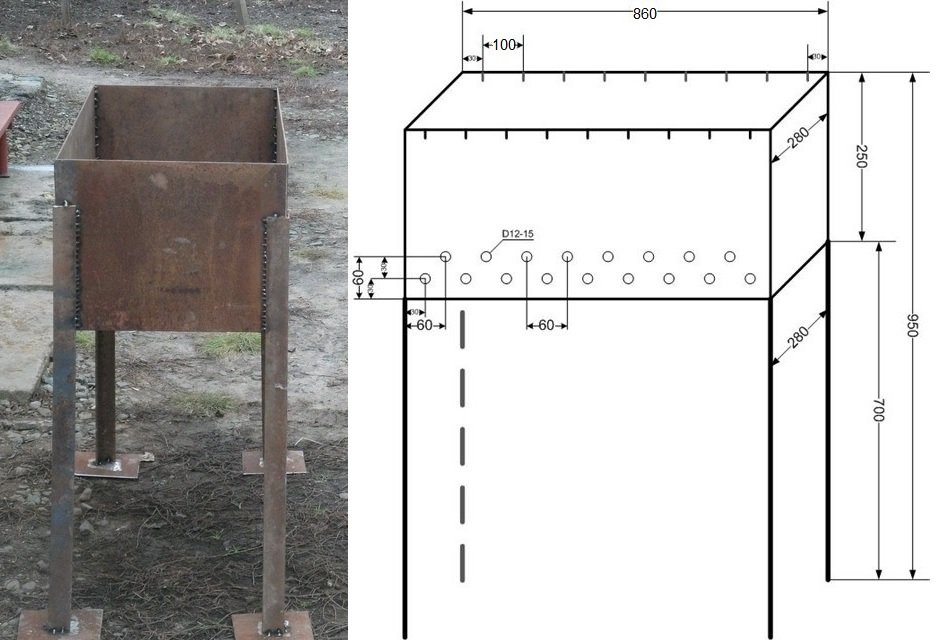
Stationary brazier and its drawing
What material to choose for the manufacture of the cauldron structure: stainless steel, iron, etc.
For welding the brazier, ordinary sheet metal is best suited, from which the bottom and walls of the product are cut. The thicker you take the metal, the stronger and more reliable the brazier will be, as well as more stable. Usually take a sheet with a thickness of more than 4 mm.
The sheet should be:
- width - 80 cm - 90 cm;
- length - 80 cm - 100 cm.
Stationary models should be thick-walled as they will have a longer service life. For the manufacture of the brazier box, you can take stainless steel, ordinary ferrous metal or heat-resistant steel. Naturally, stainless and heat-resistant steel is the best option for making a stationary reliable barbecue, but also more expensive.
If you look from the point of view of savings, it is best to buy a good steel sheet and metal profiles (corners or fittings) once than to repair the brazier later, which will burn out due to low-quality metal. Ferrous metal can rust over time, and the bottom of the brazier can simply burn out with frequent use of the barbecue. Therefore, it is necessary to choose the material taking into account the intensity of operation of the future product.
Necessary tools and materials
- Sheet metal (stainless or heat-resistant steel, ordinary black rolled metal).
- Iron corners or ordinary pieces of reinforcement (individual length).
- Angle grinder (grinder), hacksaw or electric jigsaw.
- Powerful drill.
- Apparatus for welding.
Making a stationary metal barbecue maker with your own hands: step by step instructions
- On the iron sheet, it is necessary to mark with chalk in accordance with the developed drawing plan.
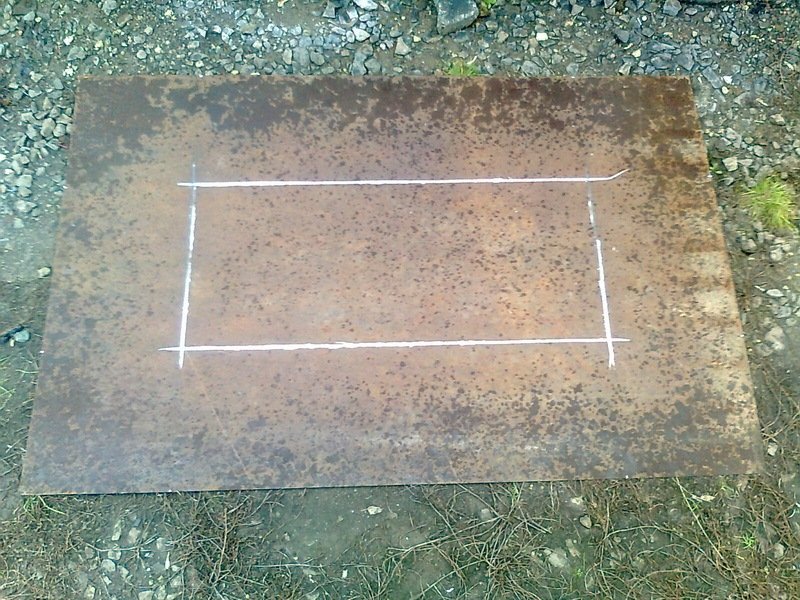
Marking a metal sheet for a future barbecue box
- Cut the sides and bottom of the structure with an angle grinder, hacksaw or electric jigsaw.
- In the lower part of all four walls of the brazier, it is necessary to drill symmetrical holes around the entire perimeter, which will facilitate the flow of air from the outside to speed up the ignition of logs or coals. Also, at the bottom of the brazier box, you can make a special perforation with a grinder for constant air circulation.
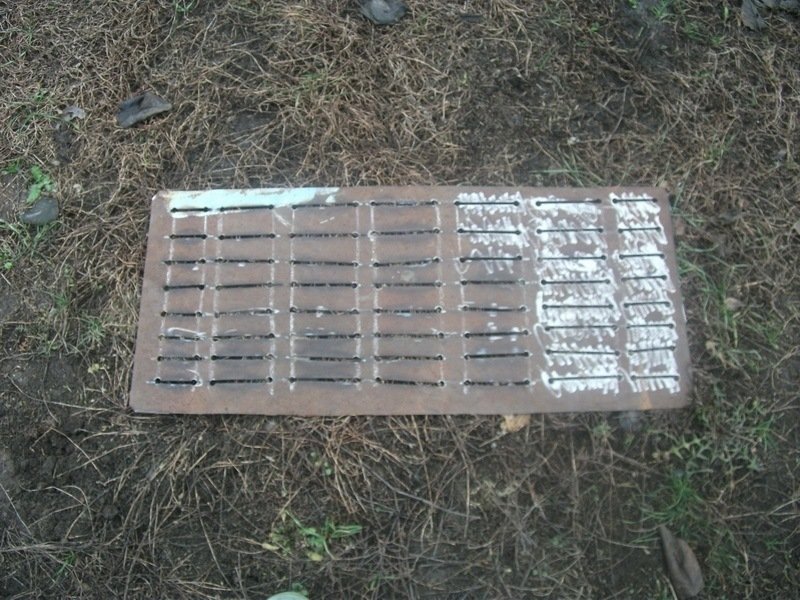
Perforation of the bottom of the brazier for better air circulation
- On the upper part, along the entire length of the walls, it is necessary to make holes for laying skewers. This can be done with a grinder. The distances between them must be strictly symmetrical with respect to the opposite side and have the same distances between them.
- Next, the walls and bottom of the brazier must be welded into a kind of rectangular box, which will make up the main part of the brazier. All welds must be well cleaned with a grinder so that they are even and have an attractive appearance.
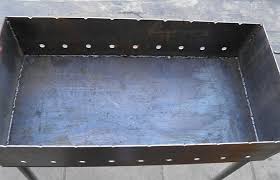
Barbecue with notches for laying skewers
- For the manufacture of legs, it is necessary to take corners or fittings and weld them to all four corners of the walls. If desired, the legs can be unscrewed. To the bottom of the brazier, you just need to weld four nuts, and cut a thread on the fittings for screwing the legs to the base of the brazier. Nuts must match the diameter of the reinforcement in their diameter. Then the legs can be easily unscrewed for more convenient storage of the brazier at the end of the season.
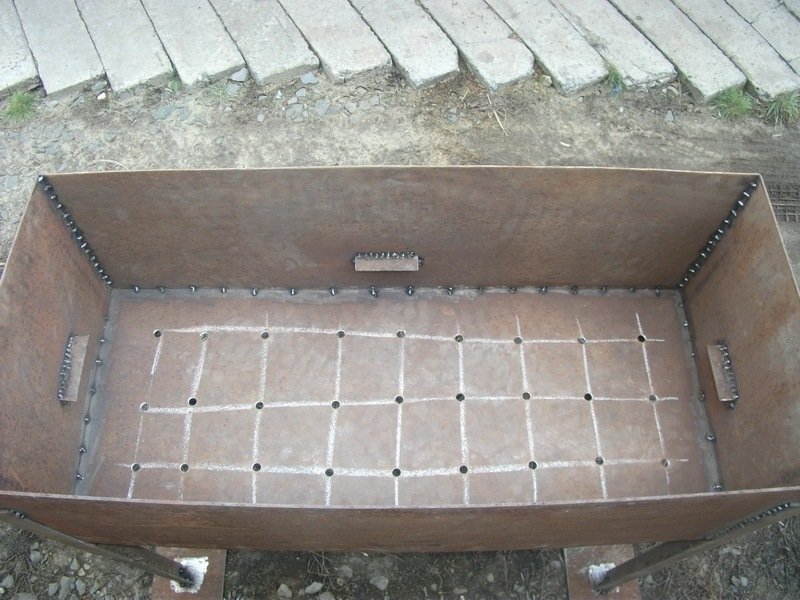
Barbecue with perforated bottom
How to finish an iron brazier, and can it be painted?
Let's see if it is necessary to paint the barbecue box and why should it be done? It is not advisable to use paint and other chemically active dyes, since in the process of burning coal or firewood, the paint will begin to peel off, emit an unpleasant odor, and the meat can absorb chemical emissions that are hazardous to health.
But at present, modern manufacturers can offer special products for coloring the entire structure of the brazier, which are completely safe for people nearby and for meat, vegetables and other products cooked on it.
The only problem is that the temperature inside the brazier is so high that any coating (even a very resistant one) can simply burn out and crumble quickly.
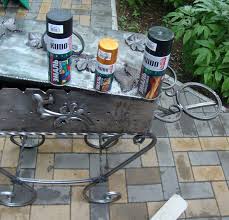
Heat-resistant paints for coloring the barbecue
Today there are such heat-resistant paints as:
- Organosilicon enamels that can withstand heat temperatures up to +600 degrees Celsius.
- Heat-resistant powder paints are great for painting a brazier, but they are quite difficult to apply, as they must be fired at a very high temperature.
- The oxidation process is quite complicated, but if desired, it can also be carried out in an artisanal way at home. To do this, the barbecue box must be treated with five percent sulfuric acid. Then boil in a thick solution of alkaline soap and cook for about one and a half or two hours in a sodium solution. After these "water" procedures, the metal will be covered with a black non-stick coating, which will keep it from corrosion. But this method is very unsafe, since working with a chemical such as sulfuric acid requires great care.
Video: construction of a steel barbecue oven
Video: homemade design option
Projects, sketches and features of the manufacture of a collapsible and folding barbecue
Collapsible brazier for a summer residence
Such a brazier is very easy to decompose into separate elements that will not take up much space during its storage.
The design of the brazier does not provide for welding all its parts, so a welding machine may not be needed here. And in order for the sidewalls and legs of the barbecue to be removed, we only need bolts and nuts.
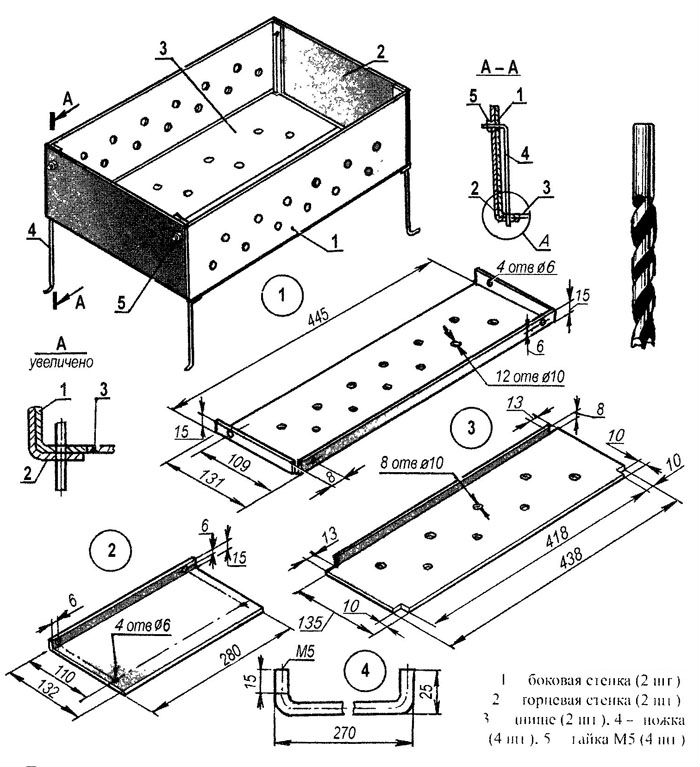
Drawing of a collapsible brazier
How to do
- First you need to mark all the details of the product on the iron sheet. On the sides and bottom, add about 4 cm to the joints as indicated in the diagram.
- Then all the details must be cut out.
- In order to be able to bend the sheets, it is necessary to make small cuts on the sides on the cut sides. Then it will be possible to dock the corners and the bottom can be easily laid inside the frame.
- So that the entire structure of the “box” of the brazier does not fall apart during the preparation of kebabs, holes must be made at the ends of the walls and firmly fixed with bolts.
- On the upper part of the sides of the brazier, it is necessary to make notches at the same distance for laying skewers.
- The legs must be made from 4 iron corners, in which holes for bolts must also be made, as well as in the corners of adjacent walls to which they will be attached.
- For better air access at the very bottom of the box walls, small holes must be made with a drill or grinder.
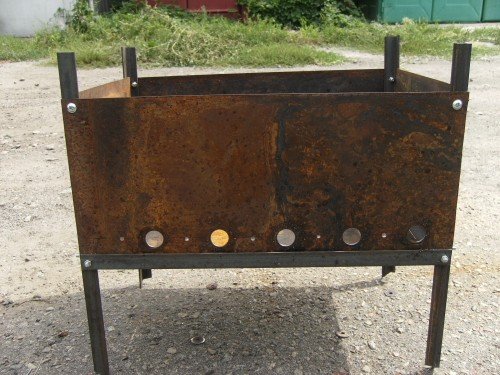
View of the finished collapsible barbecue
Folding brazier
Such a camping brazier can also be made in the yard of your house and it will be a great option for country picnics. When folded, it is a small iron suitcase with a portable device. The thickness of such a "suitcase" is only 40 mm, and the length is from 65 to 85 cm. You can put skewers or a grill grate into it.
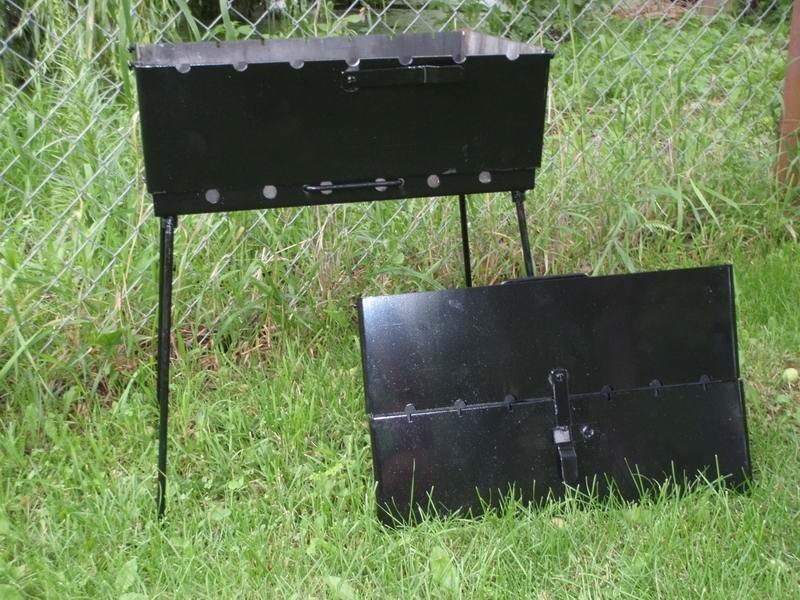
Folding brazier in the form of a suitcase
How to cook
- It is necessary to cut out the bottom of the brazier from a sheet of iron and drill round holes on the sides with a drill with a diameter of about 10 mm for air flow. Then bend the sidewalls along the line shown in the drawing.
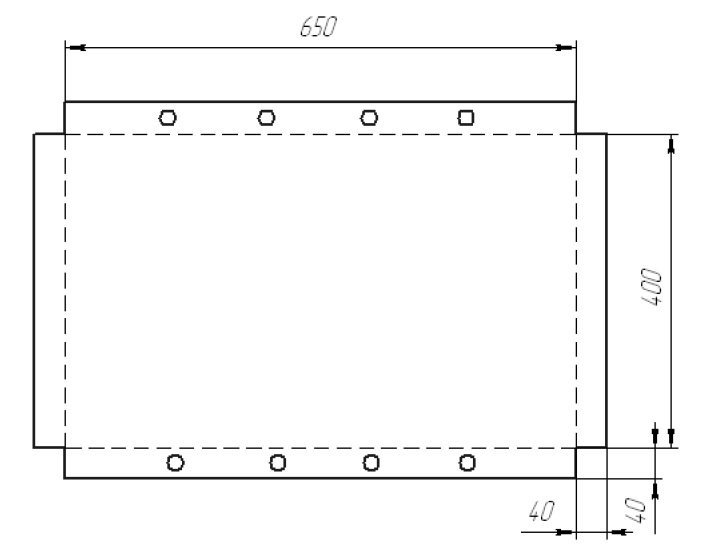
Folding brazier bottom drawing
- Cut out the sides (size 62x20.5 cm).
- In order for them to easily fold inside the “suitcase”, two small loops (canopy) must be fixed between the bottom and the walls. This can be done with screws or welding.
- Next, you need to cut the end removable walls. When assembled, they will be inserted into the sides and bottom. To do this, along all the edges of the side walls, it is necessary to make rectangular thin slots.
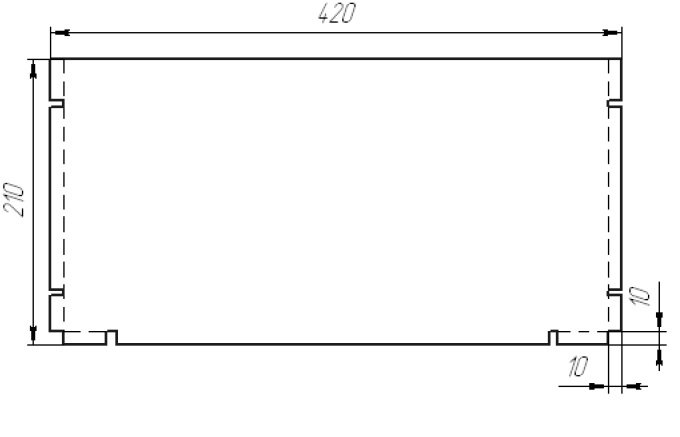
Drawing of the walls of the brazier folding
- Four nuts must be welded to the bottom of the bottom, which are necessary for the screwed legs.
- For their manufacture, it is necessary to take four rods of reinforcement, 60 cm long, and on each of them it is necessary to make a thread (1 cm M8 each). During assembly, the legs can be screwed in with the welded nuts.













